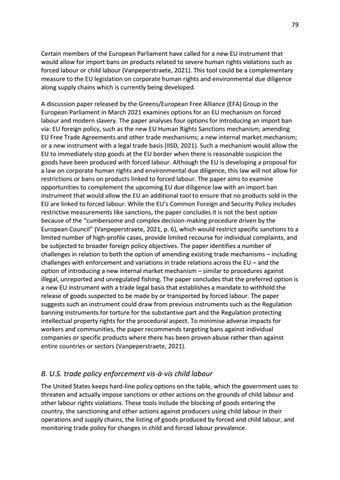79
Certain members of the European Parliament have called for a new EU instrument that would allow for import bans on products related to severe human rights violations such as forced labour or child labour (Vanpeperstraete, 2021). This tool could be a complementary measure to the EU legislation on corporate human rights and environmental due diligence along supply chains which is currently being developed. A discussion paper released by the Greens/European Free Alliance (EFA) Group in the European Parliament in March 2021 examines options for an EU mechanism on forced labour and modern slavery. The paper analyses four options for introducing an import ban via: EU foreign policy, such as the new EU Human Rights Sanctions mechanism; amending EU Free Trade Agreements and other trade mechanisms; a new internal market mechanism; or a new instrument with a legal trade basis (IISD, 2021). Such a mechanism would allow the EU to immediately stop goods at the EU border when there is reasonable suspicion the goods have been produced with forced labour. Although the EU is developing a proposal for a law on corporate human rights and environmental due diligence, this law will not allow for restrictions or bans on products linked to forced labour. The paper aims to examine opportunities to complement the upcoming EU due diligence law with an import ban instrument that would allow the EU an additional tool to ensure that no products sold in the EU are linked to forced labour. While the EU’s Common Foreign and Security Policy includes restrictive measurements like sanctions, the paper concludes it is not the best option because of the “cumbersome and complex decision-making procedure driven by the European Council” (Vanpeperstraete, 2021, p. 6), which would restrict specific sanctions to a limited number of high-profile cases, provide limited recourse for individual complaints, and be subjected to broader foreign policy objectives. The paper identifies a number of challenges in relation to both the option of amending existing trade mechanisms – including challenges with enforcement and variations in trade relations across the EU – and the option of introducing a new internal market mechanism – similar to procedures against illegal, unreported and unregulated fishing. The paper concludes that the preferred option is a new EU instrument with a trade legal basis that establishes a mandate to withhold the release of goods suspected to be made by or transported by forced labour. The paper suggests such an instrument could draw from previous instruments such as the Regulation banning instruments for torture for the substantive part and the Regulation protecting intellectual property rights for the procedural aspect. To minimise adverse impacts for workers and communities, the paper recommends targeting bans against individual companies or specific products where there has been proven abuse rather than against entire countries or sectors (Vanpeperstraete, 2021).
B. U.S. trade policy enforcement vis-à-vis child labour The United States keeps hard-line policy options on the table, which the government uses to threaten and actually impose sanctions or other actions on the grounds of child labour and other labour rights violations. These tools include the blocking of goods entering the country, the sanctioning and other actions against producers using child labour in their operations and supply chains, the listing of goods produced by forced and child labour, and monitoring trade policy for changes in child and forced labour prevalence.













